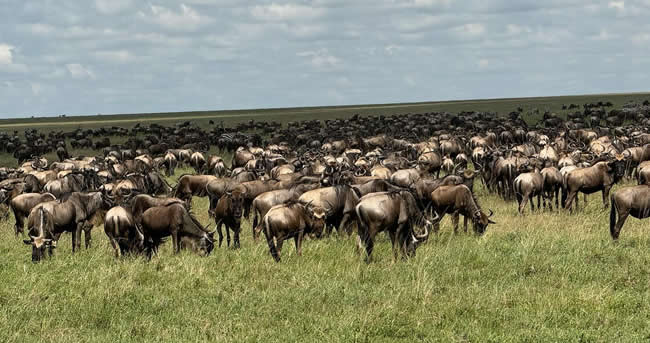Tanzania’s Serengeti National Park is surely one of the worlds most famous and beautiful wildlife refuges. This huge expanse of the African savannah, which covers an area of over 14,750 square kilometers, is well-known for both its incredible wildlife richness and the amazing yearly migration of millions of wildebeest, zebra, and gazelles. The Serengeti National Park was created in 1951 and is now recognized for its exceptional global worth to both people and the natural environment by being inducted as a UNESCO Environment Heritage Site.
A major attraction of Serengeti National Park is the Great Migration, which is frequently referred to as the “Greatest Show on Earth.“ Following ancient instinctive patterns, over a million wildebeest and hundreds of thousands of zebras and gazelles traverse the plains annually in search of new grazing sites. In addition to attracting tourists from all over the world, this natural spectacle maintains a fragile ecosystem that is home to lions, cheetahs, and hyenas, among other predators, who thrive on the availability of prey.
Beyond the migration, the Serengeti National Park provides an incredible diversity of ecosystems, such as rivers, kopjes (rock outcroppings), grasslands, and woods, all of which are home to a wide range of wildlife. More than 500 bird species and over 70 large mammal species can be found in the park, including the stately African elephant and the elusive leopard. The Big Five lions, elephants, buffaloes, leopards, and rhinoceroses as well as numerous more amazing animals in their natural habitat are available for visitors to see.
In addition to having a variety of wildlife, Serengeti National Park holds great cultural importance. Having spent decades living here, the Maasai people have a strong bond with the region’s fauna. Their cooperation with the wildlife on their regular grazing grounds, which border the park, is evidence of the delicate balance that exists between human activity and conservation efforts. Engaging with Maasai villages allows park visitors to learn about their traditions, customs, and the difficulties they confront in maintaining their way of life in the contemporary era.
The Serengeti National Park is an outstanding example of both a natural wonder and successful conservation. Its expansive, vibrant landscapes inspire wonder and appreciation for the natural world. Its plains, forests, and rivers attract exploration, and those who do so become participants in an age-old tale of life, death, and the never-ending cycle of nature rather than just viewers. Serengeti National Park is more than just a travel destination; it is evidence of the wilderness’s ongoing beauty and resiliency.
Best Activities to do in Serengeti National Park
- Game Drives
Serengeti National Park’s vast savannahs and varied ecosystems provide a unique safari experience. During game drives over the park’s vast landscape, guests can see lions, elephants, giraffes, and other classic African species in their natural habitat. Any visitor to the park should experience a game drive; with experienced guides guiding the way, it’s an adventure full of exciting wildlife sightings and amazing views.
- Great Migration

A once-in-a-lifetime opportunity to witness the Great Migration captures the pure magnificence and drama of the natural world. During the yearly migration of millions of wildebeest, zebras, and gazelles over the Serengeti plains, tourists may experience this amazing display up close. For those who are fortunate enough to see it, the sight of thousands of animals moving in tandem, brave lion-inhabited territory, and crocodile-infested waterways, is incredible and inspiring.
- Hot Air Balloon Safaris
Nothing beats a hot air balloon safari over the Serengeti at dawn for an experience that will stay with you forever. Passengers get stunning panoramic views of the park’s fauna and sceneries as they glide silently over the wide plains as the sun rises. This bird’s-eye view provides a singular and calm approach to take in the beauty of the Serengeti, from vast views of the African savannah to herds of grazing animals.
- Guided Walking Safaris
Take a guided walking safari to fully experience the sights, sounds, and smells of the Serengeti. These safaris provide a more personal and in-depth understanding of the park’s ecosystems, guided by professional guides who are proficient in locating animals and analyzing the surrounding vegetation. Walking safaris offer an enhanced experience of the natural world, allowing one to feel the pulse of the forest beneath their feet, spot trails, and learn about the flora and fauna.
- Birdwatching
Birdwatchers will find the celestial realm in the Serengeti National Park, which is home to a wide variety of bird species. With more than 500 bird species identified within its boundaries, the park provides countless chances for those who enjoy birding, such as vibrant rollers, stately raptors, and elusive ostriches. The Serengeti’s multiple ecosystems offer a sanctuary for birdlife that is likely to attract and motivate birdwatchers of all skill levels.
- Cultural Interactions
Interact with the lively Maasai people living in the Serengeti’s neighboring regions to learn about their customs. Tourists can learn about Maasai customs, traditions, and beliefs through cultural interactions like storytelling around the campfire, visits to Maasai villages, and guided tours led by members of the local community. These experiences help visitors develop a deeper appreciation for East Africa’s rich cultural heritage.
- Camping Under the Stars
Camp under the great African sky and feel the enormity of the Serengeti nights. The park offers a variety of campsites with amenities ranging from basic to luxurious. Camping offers an exceptional chance to fully lose oneself in the embrace of nature. Make lifelong memories by drifting off to sleep to the sounds of the wild and waking up to the sight of the sun rising over the savannah.
- Photographic Safaris
On a photographic safari, capture the majesty and elegance of the Serengeti via the lens of your camera. With its stunning backdrop, varied fauna, and constantly shifting light, the park provides photographers with countless chances to perfect their art and produce truly memorable shots. The Serengeti’s natural beauty is guaranteed to inspire and thrill photographers of all stripes as well as casual shooters.
Conclusion
With a wide range of activities that completely engage tourists in the beauty, diversity, and wonder of the natural world, Serengeti National Park stands as an icon of Africa’s wild nature. Experiences that will never be forgotten, such as spectacular game drives, seeing the majestic Great Migration, peaceful hot air balloon safaris, and small-group guided walking safaris. The park offers something for everyone who visits. A sense of adventure and discovery permeates every moment spent in the Serengeti, whether you’re admiring the abundant birds, interacting with the nearby Maasai villages, or camping beneath a starry sky.
